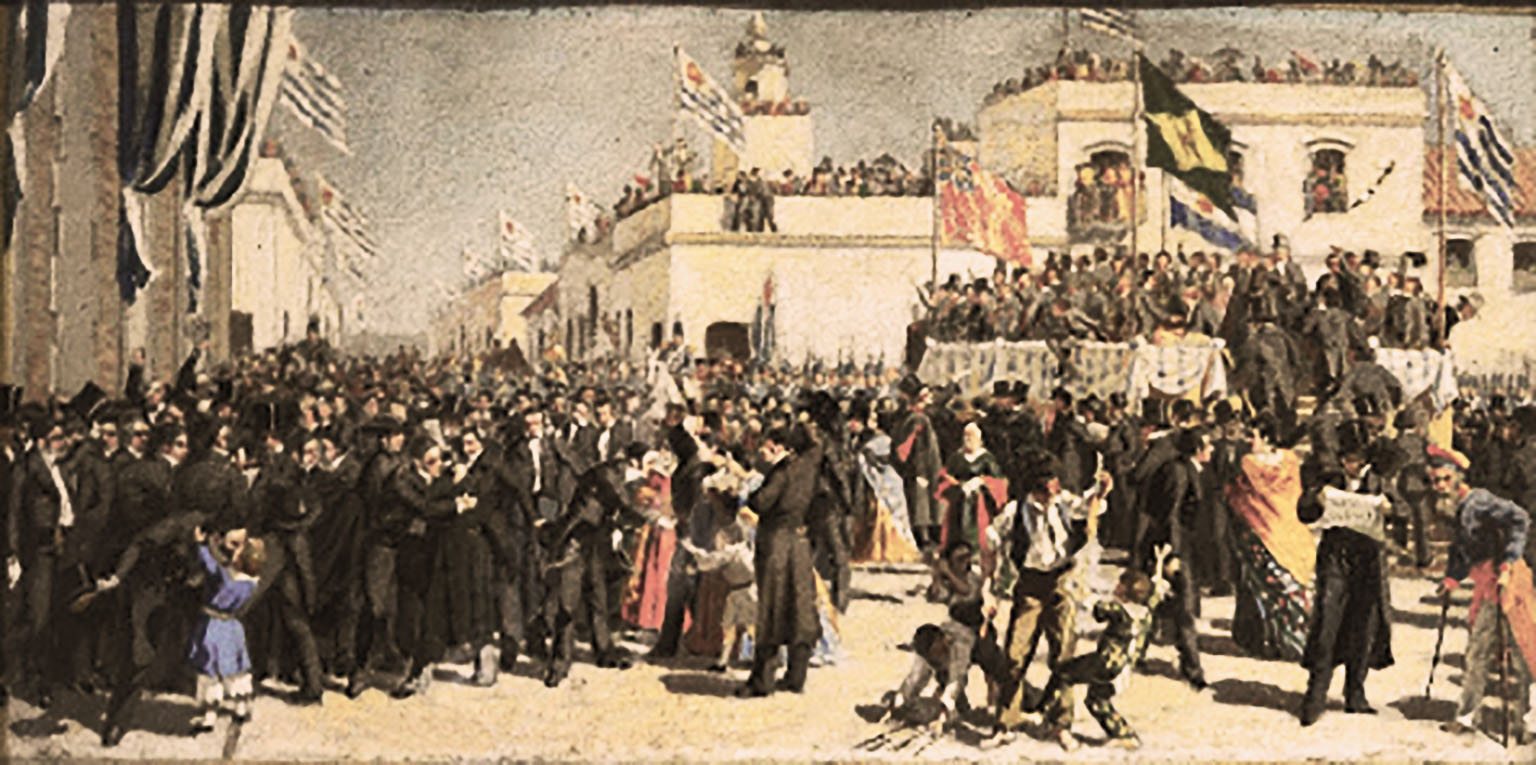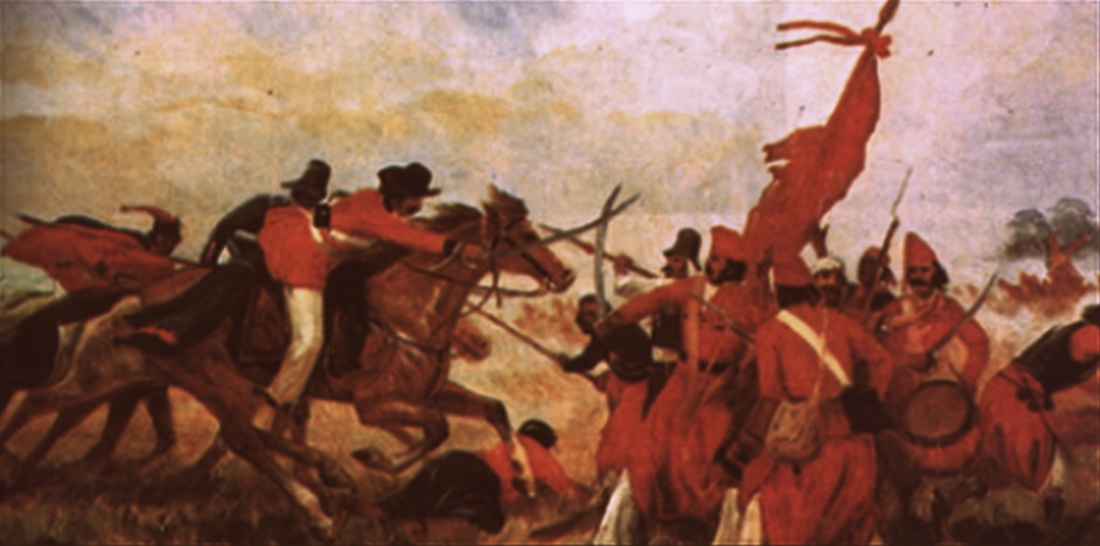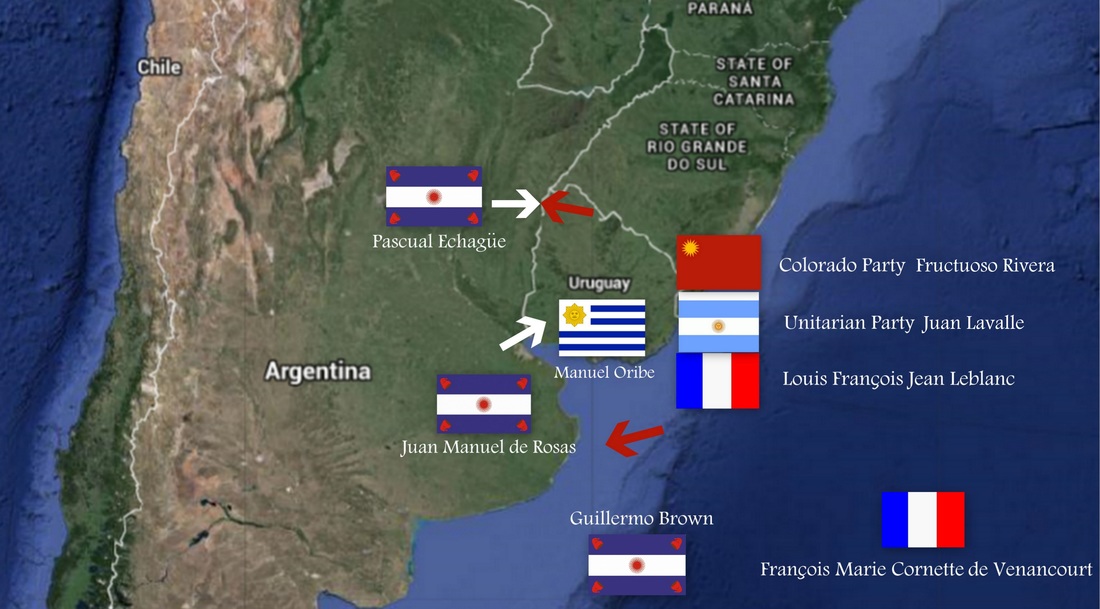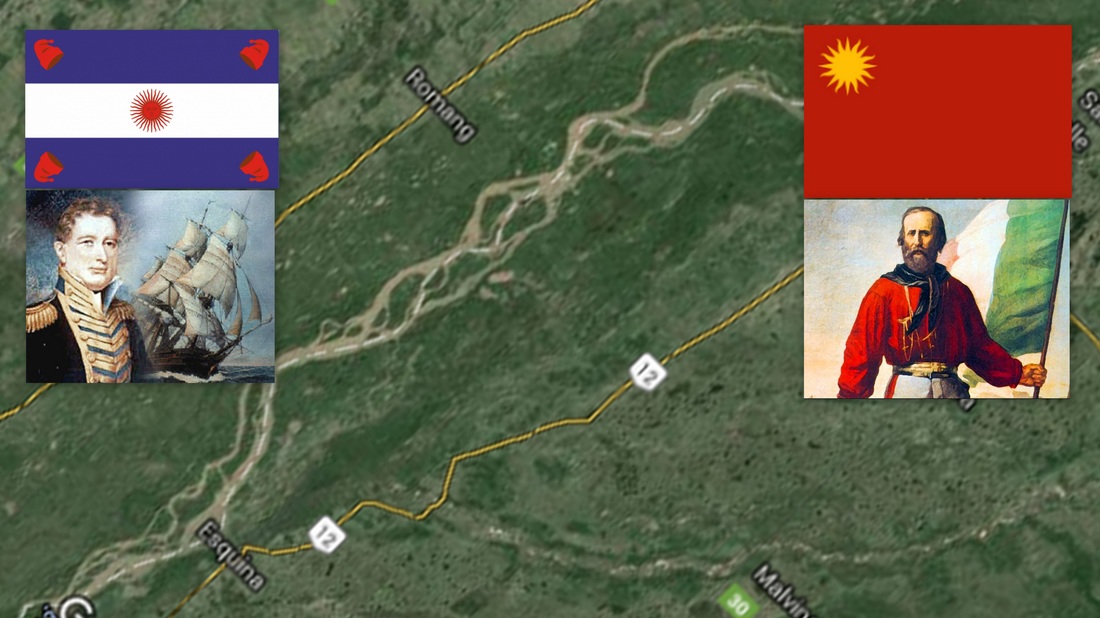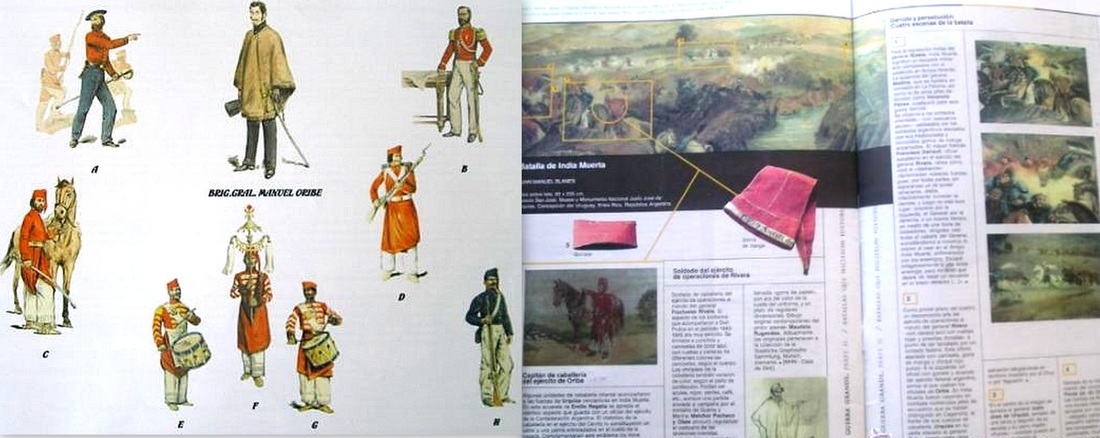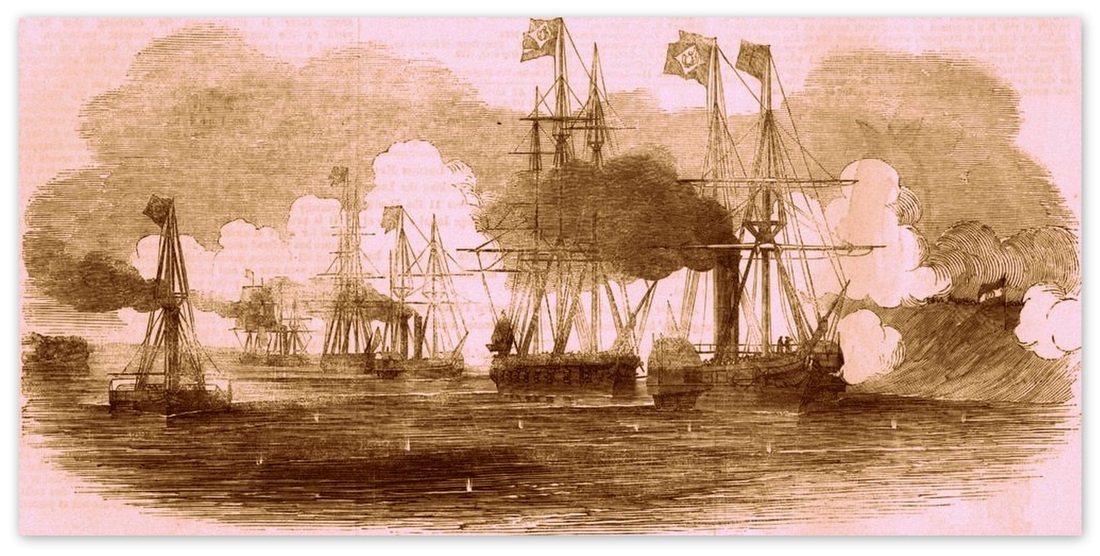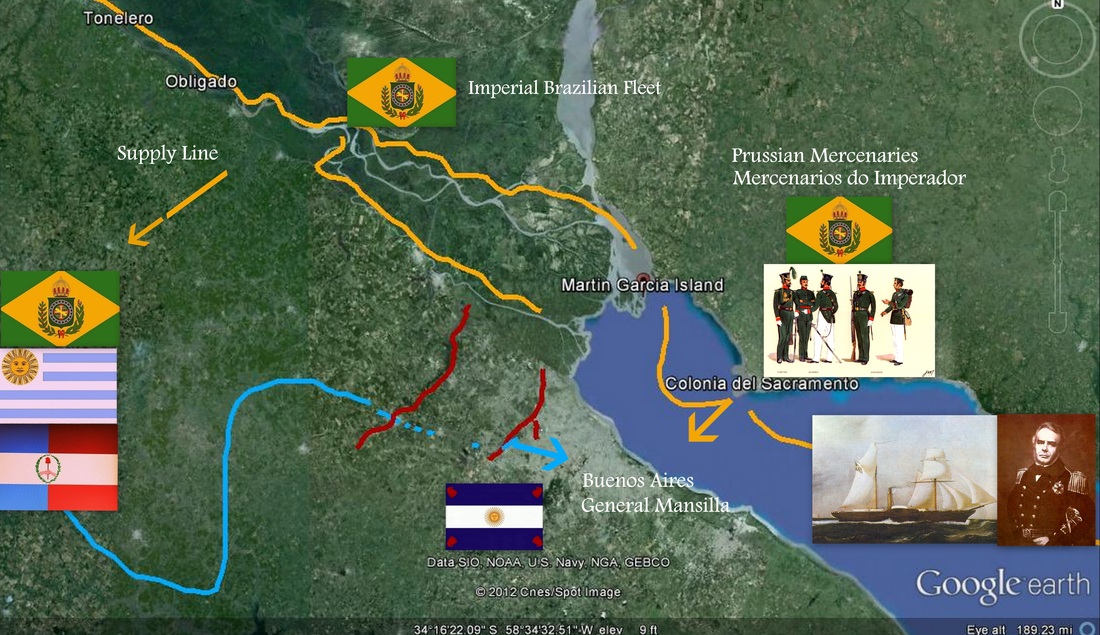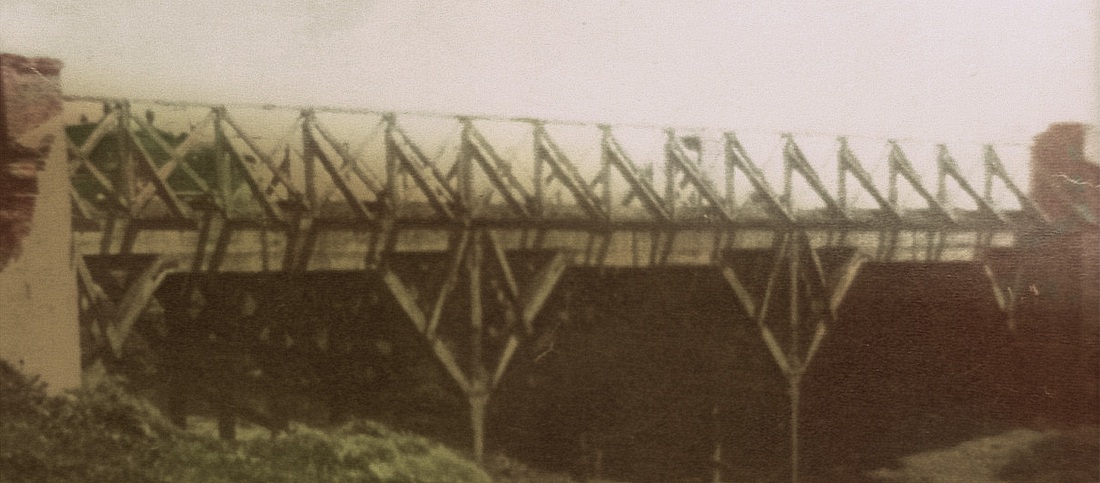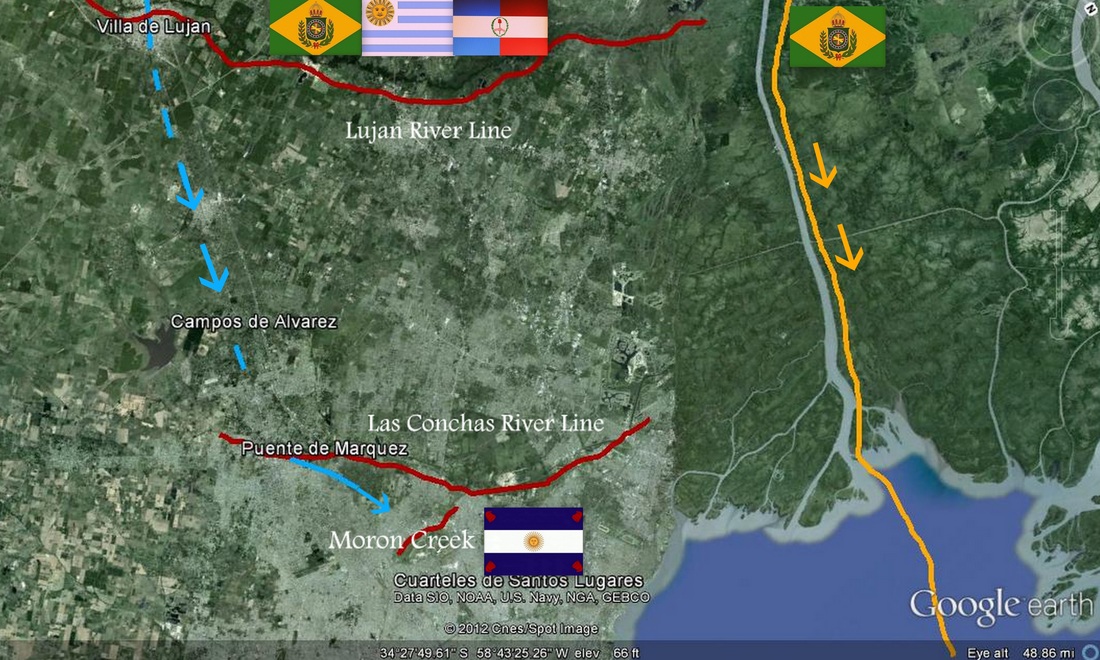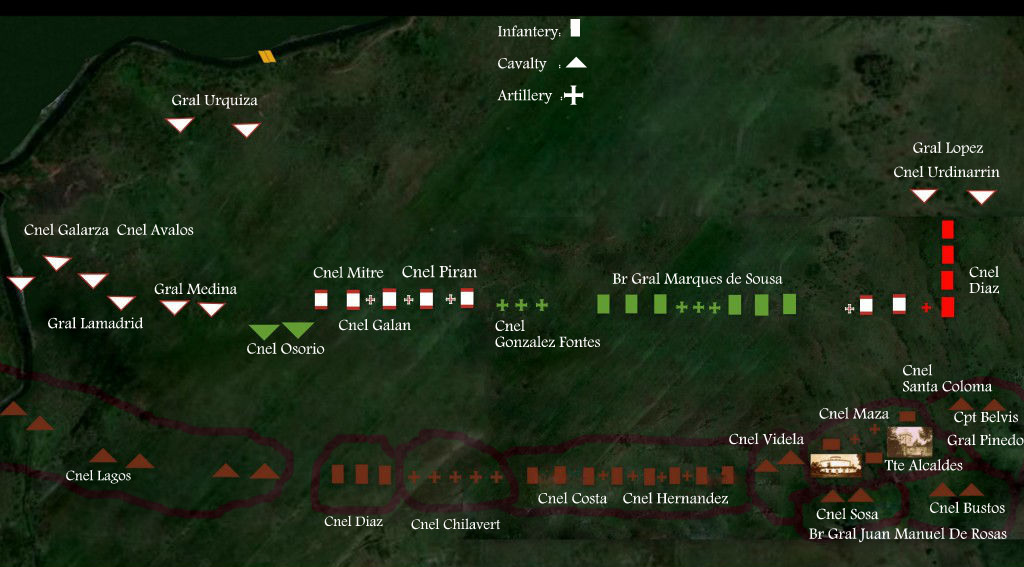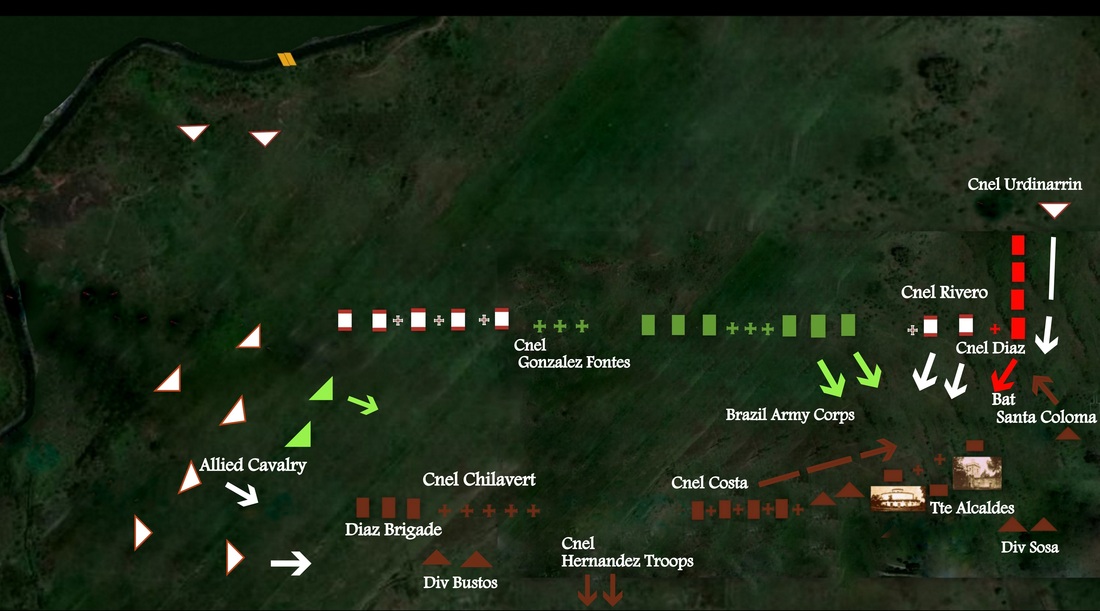Argentine-Brazilian War 1825 to 1828:
Battle of Sarandi. October 12, 1825
Battle of Ituzaingo. February 20 1827
Battle of Juncal. Febraury 8/9 1827
Battle of Monte Santiago 7/8 1827
Independence and Constitution of Uruguay 1825 - 1830.
1829 Battle of Vizcacheras. The death of Colonel Friedrich Rauch. It is a drawing of the artist Francisco Fortuny. Note the Wheel "Forage or campaign" cap.
1933-34 Indian Wars Campaigns and Desert Expedition
The objective of said campaign was to end the Indian attacks on frontier populations, free captives, and cut the contraband of stolen cows that the Indians passed into Chile. The strategy consisted of three advance lines: The left was under the command of Juan Manuel de Rosas and would operate along the Rio Colorado y Negro until the Neuquén Region; The center was under the command of Ruiz Huidobro in the Central Pampa; The right was under the command of Felix Aldao in the Andina Region. The weight of the operation was supported by Rosas' left column, who had to extend to Neuquén before the advance of the Chilean Army, itself carrying out a campaign against the Indians. An interesting note is that a young Charles Darwin (whose image is on the map), was found at that time exploring Patagonia, including the Malvinas Islands, and investigating species' evolution. On that voyage through Indian territory, he came across the Juan Manuel de Rosas' camp in the middle of the desert.
General-in-chief): Brigadier Juan Manuel de Rosas; High command chief: General Angel Pacheco.
Colonels: Manuel Corvalan (Edecan); Pedro Ramos; Antonio Ramirez; Ramon Rodriguez; Juan A. Garreton.
Lieutenant Colonels: Jose Maria Flores; Francisco Sosa; Hilario Lagos; Narciso del Valle; Miguel Miranda; Juan Pedro Luna; Juan Jose Hernandez; Roque Cepeda; Faustino Velazco; Felipe Julianes'
Sergeant Majors: Leandro Ibanez; Ventura Minana; Manuel C. Garcia, Geronimo Costa; Felix A. Meneses; Joaquin Casco; Rafael Fuentes; Bernardo Echeverria.
I addition to military personnel and maintenance, there were civilians, medical professionals, engineers, astronomers, among other.
Colonels: Manuel Corvalan (Edecan); Pedro Ramos; Antonio Ramirez; Ramon Rodriguez; Juan A. Garreton.
Lieutenant Colonels: Jose Maria Flores; Francisco Sosa; Hilario Lagos; Narciso del Valle; Miguel Miranda; Juan Pedro Luna; Juan Jose Hernandez; Roque Cepeda; Faustino Velazco; Felipe Julianes'
Sergeant Majors: Leandro Ibanez; Ventura Minana; Manuel C. Garcia, Geronimo Costa; Felix A. Meneses; Joaquin Casco; Rafael Fuentes; Bernardo Echeverria.
I addition to military personnel and maintenance, there were civilians, medical professionals, engineers, astronomers, among other.
1833-34 Desert Campaign. Rosas, General Pacheco and Colonel "Edecan",Corvalan by Jose Manuel Blanes.
Orde of battle:
Infantry:
1st Batallion (Patricios Regiment): Colonel Antonio Ramirez
Line Piquetes (Platoon-Section): Colonel Ramon Rodriguez
Artillery: (1-Battery), Colonel Juan Pedro Luna
Cavalry:
Line Squadron of the N2 Regiment: Colonel Hilario Lagos
Line Squadron of the N3 Regiment: Colonel Miguel Miranda
Line Squadron of the N4 Regiment: Colonel Jose Maria Flores
Piquete (Platoon-Section) of the N5 Regiment: Major Ventura Miñana
N6 Squadron: Lieutenant Colonel Roque Cepeda
N9 Regiment: Lieutenant Colonel Narciso del Valle
N10 Regiment: Lieutenant Colonel Francisco Sosa
Escort Squadron: Lieutenant Colonel Juan Jose Luciano Hernandez
1st Batallion (Patricios Regiment): Colonel Antonio Ramirez
Line Piquetes (Platoon-Section): Colonel Ramon Rodriguez
Artillery: (1-Battery), Colonel Juan Pedro Luna
Cavalry:
Line Squadron of the N2 Regiment: Colonel Hilario Lagos
Line Squadron of the N3 Regiment: Colonel Miguel Miranda
Line Squadron of the N4 Regiment: Colonel Jose Maria Flores
Piquete (Platoon-Section) of the N5 Regiment: Major Ventura Miñana
N6 Squadron: Lieutenant Colonel Roque Cepeda
N9 Regiment: Lieutenant Colonel Narciso del Valle
N10 Regiment: Lieutenant Colonel Francisco Sosa
Escort Squadron: Lieutenant Colonel Juan Jose Luciano Hernandez
Source: Historia de la Confederación Argentina: Rozas y su época, Volume 2 by Adolfo Saldias.
1931-1833 USS Lexington attack and British Occupation.
As a consequence of the control against poaching and deaths of seals, the Argentine government detained 3 fishing ships of US origin (Harriet, Superior y Breakwater). On December 28, 1831, the sloop USS Lexington, under the command of Captain Silas Dunkan, attacked and destroyed Puerto Soledad with naval fire and landing troops. Interestingly, the American ship used a French flag. After these events, the British crown ordered its fleet based in Rio de Janeiro, Brazil to occupy the Malvinas Islands. On January 3, 1833, the British began to occupy the islands. Commander John James Onslow at the head of the HMS Clio Cruizer class brig-sloop, supported by the Corvette Tyne, made the Argentine troops surrender. They were under the command of Navy Lieutenant-Colonel José María Pinedo at the head of the Schooner ARA Sarandi. The islands were taken for the British Crown of King William IV.
1844: Sailing frigate USS Congress (1841) and other US ships against the Argentine Confederation Fleet during the naval blockade of Montevideo.
According to Wikipedia: "Congress was launched at the Portsmouth Navy Yard on August 16, 1841 and placed in commission under Captain Philip Voorhees on May 7, 1842. Her first cruise, starting on July 15, took her to the Mediterranean for service with the Squadron of Commodores Charles W. Morgan and Charles Morris. In December 1843, Voorhees joined Commodore Daniel Turner's Brazil Squadron blockading Montevideo in safeguarding U.S. trade during the Uruguayan Civil War. On September 29, 1844, Voorhees captured an armed Argentine schooner that delivered a mail to the Argentine commanding officer.This overreaction damaged the US-Argentina relation and resulted in a court martial for Voorhees. His impetuosity resulted in a few months suspension, for Voorhees, but did little damage to his career. Congress remained active in the theatre until January 1845. She was then placed in ordinary at Norfolk, Virginia in March".
Farrapos War 1835 - 1845. (Rio Grande - Santa Catalina)
The current territory of Rio Grande del Sur was found, in colonial times, within the Viceroy of the Rio de la Plata. Under the name of Rio Grande it was known originally as a region on the Atlantic coast on the Oriental Band (Uruguay), in south-central South America and belonged to Spain. Its borders were the Jesuit Missions situated to the east of the Uruguay River, on the Oriental Band. There one could find the Siete Pueblos de las Misiones (Seven Towns of the Missions). These towns were as gaucho as Argentines, Uruguayans, and Paraguayans. Despite being border territory between Spain and Portugal, with the decline of the Spanish Empire they were impotent in avoiding the Luso-Brazilian penetration in Rio Grande. Annexed by Portugal (later Brazil) in definitive form through the War of Brazil and the Guerra Grande (as a way of repaying debts from the Liberal Colorado Party ).
In this separatist war "Ragamuffin or Farrapos War" (Guerra en harapos), lasting between 1835 and 1845 ", we find the separatist Liberal republics Rio-Grande and Juliana (Catarina - Catarinense Republic being supported by the Liberal Unitarian forces, the Colorado Party, the Argentine Unitarians, and foreigners like the Red Shirts of Giuseppe Garibaldi (Santa Catalina), against the Brazilian Empire. The above photo in particular seems to be of Argentine Federal forces, but with the red flag would indicate the Colorado Party (itself a separation from the Argentine Confederation). This shows how the Unitarians like the Argentine Federals, and the correlating groups in Uruguay, Colorados and Blancos, dressed and equipped themselves exactly the same. For this reason the federals used a red ribbon (Cintillo Punzo), to differentiate themselves. In these wars the participation of Indian parties could also be counted on at times.
Sources: Wikipedia.
Sources: Wikipedia.
Battle of Quebracho Herrado 1840 by Artist Carlos Morel.
Battle of Famaillá september 1841, Lithography Author Anonymus (Left); Battle of Arroyo Grande 1842 by Artist Carlos Descalzo (Right).
During the battle, the Unitarian Lieutenant-General Juan Esteban Pedernera (Left) challenged Federal Colonel Hilario Lagos; chief of the right wing of General Manuel Oribe's troops; (Right) to a duel that never occurred. This practice of dueling between military chiefs was apparently common. In 1833 Colonel Hilario Lagos dueled with Indian cacique chief Pitriloncoy en Choele Choel, defeating him to take the strategic island.
This Colonel Hilario Lagos was the protagonist in many adventures. Curiously, his son followed his career and came to be a general. They shared the same name, which causes some confusion.
This Colonel Hilario Lagos was the protagonist in many adventures. Curiously, his son followed his career and came to be a general. They shared the same name, which causes some confusion.
Battle of Catamarca, october 1841.
1837 - 1838 war with the Peruvian-Bolivian Confederation
As part of the War between the Confederation Peru - Bolivia vs. Chile and its Peruvian partners who opposed the confederation between their country and Bolivia; A new front of war was produced between the Peru- Bolivia Confederation against Argentina, which was at that time in war against France and its allies Argentine Unitarians. The most important reason why they went to war was for the annexation of the region of Tarija to Bolivia, (Former Argentina Province of the United Provinces of the Rio de la Plata) and due to the Peruvian -Bolivian support to the argentine unitarians during the Civil War. Both confederations found themselves in wars on other fronts, for this reason they had limited military resources. Juan Manuel de Rosas request the command of the General Heredia to the organization. Heredia counted with forces from the northern provinces . On the side of the Peru- Bolivia, General Santa Cruz assigned to General Otto Philipp Braun (who stood out in this conflict), to carry out the offensive. Braun at the inactivity of the Gral Heredia, decided to move to invading the northern provinces. This war was a military victory for Otto Braun forces over Alejandro Heredia. But Argentina kept the Northern Provinces of Salta and Jujuy, although it was not possible to recover the former argentine province of Tarija; whose inhabitants chose to be part of Bolivia. Among a series of battles of this war, the combat in Montenegro was a great victory for the forces of Otto Braun:
Combats of Humauaca and Santa Barbara: Between 12 and 13 September 1837 Colonel Felipe Heredia forces defeat forefront of Otto Braun. Combat of Vicuñay (Puna): December 11 1837, Argentine forces get another victory.
On November 17, 1837 the Chilean forces under General Blanco Encalada in Arequipa were surrounded and were forced to withdraw by a peace agreement "that was not to be definitive but temporary. This gave an opportunity to Santa Cruz to send reinforcements to Otto Braun and continue to advance in Argentine territory, making Argentine troops withdraw.
On January 2, 1838 an Argentine detachment captured a detachment of Braun in a battle called "Combat Corner of Casillas."
That night near there, in a place known as "Negra Muerta", two Bolivian forces in a mountain area, fought each other by mistake
Colonel Gregorio Paz recuperated San Antonio de los Cobres. The Argentine Colonel Mateo Rios moved from Oran to Iruya Argentina and Lieutenant Colonel Baca attacked to drive back Otto Braun. Chile, having unknown previous Peace treaty with Peru-Bolivia, back to the War. This meant reducing the chances of General Otto Braun may have more resources to invade northern provinces. But Argentina also fought on another front against the French fleet of Admiral Leblanc.
Alejandro Heredia was able to form an army of three divisions: 1 under General Manuel Virto who was to advance along the gorge of Humauaca move towards Iriuya and cut off the retreat of Braun; 2 General Gregorio Paz who should fill Tarija, and approach Chuquisaca; 3 And finally the German General Paul would become the rearguard. June 5, 1838 Andres de Santa Cruz sent to Napoleon Bonetti to reach an agreement with General Alejandro Heredia; saving a second front, at the back of Chileans to war. The problem with Bonetti, was that it was an Argentine unitarian exiliden in Bolivia and declared a fugitive in Argentina. Heredia did not recognize his diplomatic immunity and imprisoned him. General Santa Cruz called for the immediate release of Bonetti. Given the negative of Heredia, Santa Cruz would continue the offensive.
The Argentine general Gregorio Paz began the march on April 27, 1838 from Humahuaca, marching around the area jungles of Yungas and Chaco. May 29 the"Combat of Acambuco Lagoon" was fought and Argentine forces entered Bolivian territory, taking the town of Carapari. The July 3, 1838 the General Gregorio Paz gets the victories of "Combat Zapatera and San Diego" entering the Province of Tarija. On June 9 the Combat "El Pajonal" occurs. In the "Combat of Montenegro" Braun destroyed the rear of General Paz, who had approached Tarija; and forced him to start his retreat. The column of General Manuel Virto, after attempting to take the city of Iruya, also had to retire. The August 22, 1838, Brigadier General Alejandro Heredia ordered the retreat to Jujuy.
Combats of Humauaca and Santa Barbara: Between 12 and 13 September 1837 Colonel Felipe Heredia forces defeat forefront of Otto Braun. Combat of Vicuñay (Puna): December 11 1837, Argentine forces get another victory.
On November 17, 1837 the Chilean forces under General Blanco Encalada in Arequipa were surrounded and were forced to withdraw by a peace agreement "that was not to be definitive but temporary. This gave an opportunity to Santa Cruz to send reinforcements to Otto Braun and continue to advance in Argentine territory, making Argentine troops withdraw.
On January 2, 1838 an Argentine detachment captured a detachment of Braun in a battle called "Combat Corner of Casillas."
That night near there, in a place known as "Negra Muerta", two Bolivian forces in a mountain area, fought each other by mistake
Colonel Gregorio Paz recuperated San Antonio de los Cobres. The Argentine Colonel Mateo Rios moved from Oran to Iruya Argentina and Lieutenant Colonel Baca attacked to drive back Otto Braun. Chile, having unknown previous Peace treaty with Peru-Bolivia, back to the War. This meant reducing the chances of General Otto Braun may have more resources to invade northern provinces. But Argentina also fought on another front against the French fleet of Admiral Leblanc.
Alejandro Heredia was able to form an army of three divisions: 1 under General Manuel Virto who was to advance along the gorge of Humauaca move towards Iriuya and cut off the retreat of Braun; 2 General Gregorio Paz who should fill Tarija, and approach Chuquisaca; 3 And finally the German General Paul would become the rearguard. June 5, 1838 Andres de Santa Cruz sent to Napoleon Bonetti to reach an agreement with General Alejandro Heredia; saving a second front, at the back of Chileans to war. The problem with Bonetti, was that it was an Argentine unitarian exiliden in Bolivia and declared a fugitive in Argentina. Heredia did not recognize his diplomatic immunity and imprisoned him. General Santa Cruz called for the immediate release of Bonetti. Given the negative of Heredia, Santa Cruz would continue the offensive.
The Argentine general Gregorio Paz began the march on April 27, 1838 from Humahuaca, marching around the area jungles of Yungas and Chaco. May 29 the"Combat of Acambuco Lagoon" was fought and Argentine forces entered Bolivian territory, taking the town of Carapari. The July 3, 1838 the General Gregorio Paz gets the victories of "Combat Zapatera and San Diego" entering the Province of Tarija. On June 9 the Combat "El Pajonal" occurs. In the "Combat of Montenegro" Braun destroyed the rear of General Paz, who had approached Tarija; and forced him to start his retreat. The column of General Manuel Virto, after attempting to take the city of Iruya, also had to retire. The August 22, 1838, Brigadier General Alejandro Heredia ordered the retreat to Jujuy.
Brigadier General Alejandro Heredia (Right) and his brother Colonel Felipe Heredia (Left). Photo: Revisionistas
1838 - 1840 Conflict with France
trom the clash between Federals and Unitarians (supported by France), a war between the Argentina Confederation and the France of Luis Philippe D'Orleans occurs.
The reason was a result of the military service system of the Confederation of Argentina. This law included, in case of a general mobilization against an invasion, that foreign residents could be recruited, with the exception of British subjects who were exempted from serving for the British recognition of Argentine independence. Unlike France, the monarchy (Charles X), had family ties with the Spanish monarchy of Fernando VII and therefore did not recognize the independence of former Spanish colonies. France demanded the same treatment and, due to the refusal of the Argentine authorities, began the French naval blockade of Argentine ports. In 1929 under the command of François Marie Cornette de Venancourt, the French fleet attacked a division of the fleet moored in port, which was then commanded by Tomas Espora.
The French blockade activated numerous revolutionary movements, opponents of the Confederation Argentina, in the provinces and in the Banda Oriental (Uruguay). Alongside the French fleet operating off the coast of Magdalena; In Atalaya a landing attempt was rejected. To carry out the actions, the French naval chief asked the government of Montevideo (Oribe) to convert its ports to a naval base for France. Given the refusal of Oribe (White Party Allied Buenos Aires), France began to militarily support the enemies (Colorado Party) of this in Uruguay, until Oribe's defeat. Rivera was installed in Montevideo with French support and formed an alliance with the Argentine Unitarians to separate the Provinces of the Litoral in the Argentine Confederation. Rosas sent Admiral Brown in support of Oribe. In Entre Rios the Federal governor Pascual Echague and Lavalleja (Uruguay), Rivera defeats, while 4000 Unitarian troops from the Province of Corrientes under General Lavalle embark on French ships to surround Buenos Aires, actions that will be unsuccessful without popular support.
The cause was that the General Lavalle (Argentine Unitarian) and Rivera (Uruguay Colorado), virtually became part of landing operations in the fleet of Counter-Admiral Luis Francisco Leblanc, causing rejection in the population.
The French support was also extended to geopolitical rivals of Buenos Aires, if the Peruvian-Bolivian Confederation of General Andres de Santa Cruz, leading to a war between this and the Confederation Argentina. At the same time, France stars in her first intervention in Mexico. For the internal enemies of the Argentine Confederation, French support was counterproductive, since the French armed intervention caused indignation and popular support to the Federal Government of Rosas. The attempt failed, the Mackau-Arana treaty ended the long blockade.
The reason was a result of the military service system of the Confederation of Argentina. This law included, in case of a general mobilization against an invasion, that foreign residents could be recruited, with the exception of British subjects who were exempted from serving for the British recognition of Argentine independence. Unlike France, the monarchy (Charles X), had family ties with the Spanish monarchy of Fernando VII and therefore did not recognize the independence of former Spanish colonies. France demanded the same treatment and, due to the refusal of the Argentine authorities, began the French naval blockade of Argentine ports. In 1929 under the command of François Marie Cornette de Venancourt, the French fleet attacked a division of the fleet moored in port, which was then commanded by Tomas Espora.
The French blockade activated numerous revolutionary movements, opponents of the Confederation Argentina, in the provinces and in the Banda Oriental (Uruguay). Alongside the French fleet operating off the coast of Magdalena; In Atalaya a landing attempt was rejected. To carry out the actions, the French naval chief asked the government of Montevideo (Oribe) to convert its ports to a naval base for France. Given the refusal of Oribe (White Party Allied Buenos Aires), France began to militarily support the enemies (Colorado Party) of this in Uruguay, until Oribe's defeat. Rivera was installed in Montevideo with French support and formed an alliance with the Argentine Unitarians to separate the Provinces of the Litoral in the Argentine Confederation. Rosas sent Admiral Brown in support of Oribe. In Entre Rios the Federal governor Pascual Echague and Lavalleja (Uruguay), Rivera defeats, while 4000 Unitarian troops from the Province of Corrientes under General Lavalle embark on French ships to surround Buenos Aires, actions that will be unsuccessful without popular support.
The cause was that the General Lavalle (Argentine Unitarian) and Rivera (Uruguay Colorado), virtually became part of landing operations in the fleet of Counter-Admiral Luis Francisco Leblanc, causing rejection in the population.
The French support was also extended to geopolitical rivals of Buenos Aires, if the Peruvian-Bolivian Confederation of General Andres de Santa Cruz, leading to a war between this and the Confederation Argentina. At the same time, France stars in her first intervention in Mexico. For the internal enemies of the Argentine Confederation, French support was counterproductive, since the French armed intervention caused indignation and popular support to the Federal Government of Rosas. The attempt failed, the Mackau-Arana treaty ended the long blockade.
French attack on the island of Martin Garcia:
One of the most heroic feats of this war between Argentina and the United Confederation of France took place on the strategic island of Martin Garcia. 110 Argentines resisted for hours during the attack on 8 boats, 40 artillery pieces, and 500 troops. It cost Geronimo Costa's men 25 deaths and 50 for Daquenet's.
The island was defended by 110 men under the command of the chief of the Patricios Regiment Colonel Jerónimo Costa. Added to these forces was Captain Juan Bautista Thorne, Goleta Sarandi commander, sent to reinforce the small garrison artillery. The trenches were not completed and the 12 guns were not properly mounted.
On October 10, a fleet of eight ships, four French and four supporters of Rivera, appeared before Martin Garcia with Daguenet suggesting that Costa surrender. After consulting with his officers, Costa refused, replying that "I just have to say that according to my duty, I am willing to hold the honor of the nation to which I belong."
On October 11, 1838 ships with 40 cannons, maintained a heavy bombardment on the position. At the end of the day and covered by artillery Allied forces landed about 500 people (150 of them Uruguayan under the command of the Italian captain Sciurano Santiago, alias Chentopé, head of Squadron Rivera), who stormed the position in three columns.
Despite the effective resistance of Costa and his men, the position was taken and the defender taken prisoner. Costa was always remembered for his heroism on Martin Garcia.
The island was defended by 110 men under the command of the chief of the Patricios Regiment Colonel Jerónimo Costa. Added to these forces was Captain Juan Bautista Thorne, Goleta Sarandi commander, sent to reinforce the small garrison artillery. The trenches were not completed and the 12 guns were not properly mounted.
On October 10, a fleet of eight ships, four French and four supporters of Rivera, appeared before Martin Garcia with Daguenet suggesting that Costa surrender. After consulting with his officers, Costa refused, replying that "I just have to say that according to my duty, I am willing to hold the honor of the nation to which I belong."
On October 11, 1838 ships with 40 cannons, maintained a heavy bombardment on the position. At the end of the day and covered by artillery Allied forces landed about 500 people (150 of them Uruguayan under the command of the Italian captain Sciurano Santiago, alias Chentopé, head of Squadron Rivera), who stormed the position in three columns.
Despite the effective resistance of Costa and his men, the position was taken and the defender taken prisoner. Costa was always remembered for his heroism on Martin Garcia.
Costa Brava (Brown defeats Garibaldi - 15 and August 16, 1842).
Battle of "India Muerta" 1845.
Left: "Historia del Ejercito de Uruguay"; Right: "Batallas que hicieron historia" by Alberto del Pino Menck. Note the forage cap in crimmson color (Carmesi/Grana).
Battle of Vuelta de Obligado. Parana River. November 20, 1845
Left: French Admiral François Thomas Tréhouart. Center: The Anglo-French squadron (11 Warship). Right: General Lucio Mansilla.
François Thomas Tréhouart (27 April 1798 - 8 November 1873) was a French admiral, notable as the last holder to date of the rank of Admiral of France, to which he was appointed on 20 February 1869. He was a recipient of the grand cross of the Order of Isabella II.
Rear Admiral Samuel Hood Inglefield CB (1783–1848) was a Royal Navy officer who went on to be Commander in-Chief, East Indies and China Station. Promoted to rear admiral in 1841,he was appointed Commander-in-Chief on the Brazils and River Plate station at a time when Uruguayan Civil War was underway. Inglefield took decisive action at this time to keep the Paraná River open so ensuring continuity of trade. He became Commander in-Chief, East Indies and China Station in 1846 and died while still serving in that role in 1848. Wikipedia.
François Thomas Tréhouart (27 April 1798 - 8 November 1873) was a French admiral, notable as the last holder to date of the rank of Admiral of France, to which he was appointed on 20 February 1869. He was a recipient of the grand cross of the Order of Isabella II.
Rear Admiral Samuel Hood Inglefield CB (1783–1848) was a Royal Navy officer who went on to be Commander in-Chief, East Indies and China Station. Promoted to rear admiral in 1841,he was appointed Commander-in-Chief on the Brazils and River Plate station at a time when Uruguayan Civil War was underway. Inglefield took decisive action at this time to keep the Paraná River open so ensuring continuity of trade. He became Commander in-Chief, East Indies and China Station in 1846 and died while still serving in that role in 1848. Wikipedia.
The naval Battle of Vuelta de Obligado took place on the waters of the Paraná
River on November 20, 1845, between the Argentine Confederation, under the
leadership of Juan Manuel de Rosas, and an Anglo-French fleet.
2nd Batallion "Patricios of Obligado", Reenactment Group from Argentina. The Tower rifle is authentic, captured to The British Army in 1807 and used in the Battle of Obligado in 1845. Many thanks to Oscar Turone who presides over the group.
June 4. 1846. Battle of Quebracho.
Oil of Felix Revol preserved in the Historical Museum of Santa Fe with the image of General Pascual Echagüe, governor of the province to the time of the battle of Quebracho in June 1846. Photo: ellitoral.com
May 1, 1851 Urquiza's pronouncement and the Oriental Front.
Antique painting by the famous Uruguayan painter Manuel Blanes of General Oribe inspecting the federal troops. These troops were used in campaign both in Argentine territory as well as Uruguayan. For nine years took siege on the city of Montevideo, starting in February 16, 1843, with around 3,430 soldiers and 29 pieces of artillery. Interestingly, the opposing forces besieged in Montevideo had between 7,000 and 8,000 men.
General Oribe Army:
Division General Diaz
Voluntarios Rebajados (War Veterans) y Escolta Oriental, Colonel Joaquin Ramiro.
Batallon Libertad (Oriental) Colonel Lasala.
Batallon "Defensores de la Libertad" ( plus 1 Artillery Battery) Colonel Mariano Maza.
Batallon Independencia (Oriental) Colonel Mario Rincon.
Batallon "Defensores de la Independencia" Colonel Geronimo Costa.
Batallon "Libres Voluntarios" de Buenos Aires Colonel Pedro Ramos.
Batallon Escolta Colonel Ramon Bustos and one company of the Restaurador Batallion,
Batallon Patricios 3 and Guardia del Monte; Colonel Cesario Dominguez.
Cavalry Units. Colonel Julian Ciriaco Sosa.
Artillery 20 pieces y and congreve rockets.
Division General Diaz
Voluntarios Rebajados (War Veterans) y Escolta Oriental, Colonel Joaquin Ramiro.
Batallon Libertad (Oriental) Colonel Lasala.
Batallon "Defensores de la Libertad" ( plus 1 Artillery Battery) Colonel Mariano Maza.
Batallon Independencia (Oriental) Colonel Mario Rincon.
Batallon "Defensores de la Independencia" Colonel Geronimo Costa.
Batallon "Libres Voluntarios" de Buenos Aires Colonel Pedro Ramos.
Batallon Escolta Colonel Ramon Bustos and one company of the Restaurador Batallion,
Batallon Patricios 3 and Guardia del Monte; Colonel Cesario Dominguez.
Cavalry Units. Colonel Julian Ciriaco Sosa.
Artillery 20 pieces y and congreve rockets.
In 1851 when Urquiza, (until then a Rosas General, commander of the Federal divisions of the province of Entre Rios) goes to the enemy side, it crosses into Uruguay with the aim of forcing Oribe to end the siege of Montevideo and grab the Argentine Federal Forces. Oribe Federal troops become trapped between his enemies in Montevideo, and the forces of Urquiza. Deprived of reinforcements and provisions, since the naval forces of England and France took the Admiral Brown fleet of the Confederation Argentina in 1845, there were not many options. Oribe gathered his commanders to decide whether to fight two fronts, or reach an agreement with Urquiza. Oribe offers the withdrawal of Argentine troops along with the return of their artillery to Buenos Aires by sea.
Urquiza rejects the offer demanding that he be handed the Argentine battalions along with their artillery, ammunition, and weapons. Oribe with Uruguayan officials ultimately accepted; the exceptions were the heads of Argentine battalions Colonel Bustos, Mariano Maza, Pedro Ramos, Geronimo Costa and José María Flores who embark to Buenos Aires leaving their respective battalions.
Abandoned, the Argentine battalions were surrounded by Uruguayan battalions and forced to surrender their weapons. These federal battalions were forced to move to camps where General Urquiza reorganized them by assigning them to enemy officers (Unitarianists or Unitarians).
Urquiza rejects the offer demanding that he be handed the Argentine battalions along with their artillery, ammunition, and weapons. Oribe with Uruguayan officials ultimately accepted; the exceptions were the heads of Argentine battalions Colonel Bustos, Mariano Maza, Pedro Ramos, Geronimo Costa and José María Flores who embark to Buenos Aires leaving their respective battalions.
Abandoned, the Argentine battalions were surrounded by Uruguayan battalions and forced to surrender their weapons. These federal battalions were forced to move to camps where General Urquiza reorganized them by assigning them to enemy officers (Unitarianists or Unitarians).
Passage of Tonelero. December 17. 1851
December 17. 1851. Passage of Tonelero. Left: John Pascoe Grenfell. Center Combat of Tonelero 1851. Right: General Lucio Mansilla. Photo: The Passage of Tonelero by Eduardo de Martino. Wikipedia.
In the context of the war against Rosas and Oribe (1850-1852), December 17, 1851, Brazil's imperial vessels successfully passed the fortifications of Tonelero in the Acevedo gorge, Argentina. Defended by the troops of the Confederation Argentina who were in a fortified position on the right bank of the river Parana. According to Brazilian sources, they described this position as a set of batteries of artillery and fortifications, with a force of two thousand men under the command of General Lucio Norberto Mansilla, and sixteen pieces of artillery.
This defense was raised as a result of the determination of Juan Manuel de Rosas to carry out a political project of reconstruction of the old Argentine Viceroyalty of La Plata (comprising the territories of Argentina, Uruguay and
Paraguay), to which the Empire of Brazil opposed.
Attacked by the Imperial Navy of Brazil under the command of Admiral John Pascoe Grenfell:
Steamboat Dom Alfonzo commanded by Captain Frigate Jesuíno Lamego Costa (future Baron de Laguna).
Steamboat "Dom Pedro II" commanded by Captain Joaquim Raymond of Lamara.
Steamboat "Recife" commanded by Captain Antonio Francisco da hair Paixão.
"Dom Alfonso" commanded by Capt. Jose Barbosa Vitorio Lomba.
The corvette Dona Francisca commanded by Captain Guilherme Parker.
The "União", commanded by Captain Francisco Vieira Rocha.
'Calliope' to commanded by the First Lieutenant Cordeiro Torres e Alvim.
Wikipedia.
This defense was raised as a result of the determination of Juan Manuel de Rosas to carry out a political project of reconstruction of the old Argentine Viceroyalty of La Plata (comprising the territories of Argentina, Uruguay and
Paraguay), to which the Empire of Brazil opposed.
Attacked by the Imperial Navy of Brazil under the command of Admiral John Pascoe Grenfell:
Steamboat Dom Alfonzo commanded by Captain Frigate Jesuíno Lamego Costa (future Baron de Laguna).
Steamboat "Dom Pedro II" commanded by Captain Joaquim Raymond of Lamara.
Steamboat "Recife" commanded by Captain Antonio Francisco da hair Paixão.
"Dom Alfonso" commanded by Capt. Jose Barbosa Vitorio Lomba.
The corvette Dona Francisca commanded by Captain Guilherme Parker.
The "União", commanded by Captain Francisco Vieira Rocha.
'Calliope' to commanded by the First Lieutenant Cordeiro Torres e Alvim.
Wikipedia.
Naval Forces: Empire of Brazil Fleet. Under Command of Admiral John Pascoe Grenfell.
In the campaign strategy in Brazil. Caxias drew up the plan of the campaign: the
allied forces would go up the river Parana to the most convenient point of
landing to march against the forces of Rosas. Part of the Brazilian fleet would
be in Colonia do Sacramento, in front of Buenos Aires in the case of a need to
threaten the capital Buenos Aires, if Rosas opposed resistance. In compliance
with the Plan de Caxias, a squadron under the command of Grenfell forced the
fortified passage in Tonelero (under General Mansilla of the Argentine Confederation). The allied army landed in Diamante Harbor and met
the forces of Rosas.
February 3, 1852. Battle of Caseros:
The strategy of Buenos Aires.
In the battle order of the Confederation Army, they had to include the prestigious General Angel Pacheco, on whom Rosas depended militarily in his strategy. But Pacheco had a passive and indifferent attitude, allowing the vanguard of the allied army to advance as his forces retreated under the command of his subordinate commanders and did not come to defend the strategically vital "Marquez" bridge. Adolfo Saldias in his "History of the Confederation Argentina" account on this amount of errors, by action or omission that brought about a battle over a small fortified perimeter around the Palomar and Caseros House with trenches and wagons in 1852. (Place now occupied by the Colegio Militar de la Nación Argentina).
According to Adolfo Saldias, Rosas left all his military responsibility on the authority of General Pacheco.
According to Adolfo Saldias, Rosas left all his military responsibility on the authority of General Pacheco.
A month before the capitulation of Oribe and delivery of their Federal Army enemies, Colonel Chilavert suggested to Rosas that Oribe's forces should march to the General Urquiza while preparing an army to invade Brazil. Rosas approved the plan but said he would consult with Pacheco.
Soon it happened that Urquiza marched on Oribe, which forced the capitulation and stayed with his army. Rosas in Urquiza had lost one of his best generals. With the loss of General Oribe and his army, surrendered to enemy officers of the Confederation and then joined in the alliance with the Empire of Brazil and Uruguayan forces of Rivera and the reduction of the fleet of Admiral Brown, Rosas was in a bad situation.
When Urquiza prepared his international army in Gualeguaychu, Colonel Chilavert pleaded with Rosas to defend the line of the Parana and offered to command it himself. Rosas said that he would consult with Pacheco. Urquiza soon moves to Gualeguaychu toward Rosario without any obstacle.
When Urquiza moves from Rosario in the direction of Buenos Aires, Pacheco ordered Mansilla to withdraw his defensive position on the Rio Parana. General Mansilla assumed that this decision by General Pacheco was intended to send him as infantry and artillery support for the cavalry of Colonel Lagos. And defend the line (Red line), of "Arroyo del Medio" where he would support the General Pacheco with his forces from Lujan. Together they would battle the "Allies." From that
position the would be covered in case of loss by the rear in Santos Lugares, which was the headquarters of Rosas. Allowing time for Rosas to receive the forces committed to the Fortifications at the containment lines of the Indians. Thus double the forces for an offensive against the "Allied Army". Rosas replied to Mansilla that he would consult with Pacheco.
position the would be covered in case of loss by the rear in Santos Lugares, which was the headquarters of Rosas. Allowing time for Rosas to receive the forces committed to the Fortifications at the containment lines of the Indians. Thus double the forces for an offensive against the "Allied Army". Rosas replied to Mansilla that he would consult with Pacheco.
Urquiza, in front of the Allies, continued his march with impunity, leading to extend his lead in "Arroyo del Medio" where Colonel Hilario Lagos was at the head of his cavalry defending. Pacheco insist that Lagos must withdraw to the
rear in Santos Lugares. Lagos protested to Rosas that he and his cavalry in spite of the order of General Pacheco would be left there to battle the invaders. Rosas replied that he is sure of his patriotism, and to harmonize their behavior with the orders of General Pacheco.
rear in Santos Lugares. Lagos protested to Rosas that he and his cavalry in spite of the order of General Pacheco would be left there to battle the invaders. Rosas replied that he is sure of his patriotism, and to harmonize their behavior with the orders of General Pacheco.
According to Adolfo Saldias, there are times when Rosas reacted upon realizing the disorganization of his forces in operations. He calls his aide, Col. Antonino Reyes (Head of the Santos Lugares quarters), and orders him to call a
"War Council" with senior officers. But the reaction lasts just a minute. It is the need to rely on the General Pacheco what changes his attitude.
"War Council" with senior officers. But the reaction lasts just a minute. It is the need to rely on the General Pacheco what changes his attitude.
Colonel Reyes suggested to Rosas that he incorporate Colonel Pedro Jose Diaz, experienced military officer (Unitarian Party), who resided in Buenos Aires after being captured by Rosas at the Battle of Quebracho. Diaz responds to the
call that despite his condition (Unitarian Party), he will fulfill its mission as a soldier to defend his country against a foreign invasion. Paradoxically, both Diaz and Chilavert were of the Unitarian party, but fought alongside Rosas
on the grounds that they defended the country from another foreign invasion. Both Diaz's Infantry Brigade and the artillery batteries of Chilavert sustained battle to the end against the Imperial Forces of Brazil, during the Battle of
Caseros.
call that despite his condition (Unitarian Party), he will fulfill its mission as a soldier to defend his country against a foreign invasion. Paradoxically, both Diaz and Chilavert were of the Unitarian party, but fought alongside Rosas
on the grounds that they defended the country from another foreign invasion. Both Diaz's Infantry Brigade and the artillery batteries of Chilavert sustained battle to the end against the Imperial Forces of Brazil, during the Battle of
Caseros.
Between January 26 and 27, 1852, General Pacheco held meetings with the enemy (General Urquiza). At that time, he had the assistants of Colonel Pedro Bustos removed from around Lujan. Colonel Bustos made this complaint through the
Colonel Reyes but Rosas did not believe it and said, "That Bustos was crazy."
Colonel Reyes but Rosas did not believe it and said, "That Bustos was crazy."
According to Saldias: "The truth is that General Pacheco's orders to leave clearly gave the allies the way through. On the 26th of January, when the Allies arrived at Cat Creek "Arroyo Del Gato", and continued from there to the Tigre lagoon (Chacras de Chivilcoy), he ordered all forces of the"Guardia de Luján" Lujan Fort to withdraw, (now the city of Mercedes), leaving only 600 men with Colonel Lagos who was the only one to face the enemy"
The allied army continued to advance from Chivilcoy to Lujan, arriving January 29, 1852. On the 30th, the enemy vanguard reaches the Alvarez fields a few kilometers from the leading divisions of the Argentina Confederation who were in
the Rio "Las Conchas", covering the strategic forward as "Puente de Marquez". That day the General Pacheco passes through the "Bridge - Puente de Marquez" without giving any orders and goes to his ranch in "Talar". The place now bears
his name "El Talar de Pacheco".
the Rio "Las Conchas", covering the strategic forward as "Puente de Marquez". That day the General Pacheco passes through the "Bridge - Puente de Marquez" without giving any orders and goes to his ranch in "Talar". The place now bears
his name "El Talar de Pacheco".
In Colonel Lagos's communications with Rosas on the approach of the Enemy, Rosas orders him to come out to meet him firmly as General Pacheco will be defending the "Puente de Marquez" with all his might. Colonel Lagos meets with Colonels
Sosa and Bustos, marching on the morning of January 31, 1852 with their light cavalry squadrons to meet the enemy.
Sosa and Bustos, marching on the morning of January 31, 1852 with their light cavalry squadrons to meet the enemy.
The best Confederation Argentina squads clashed in "Campos de Alvarez" with numerous allied cavalry. Despite the numerical inequality with cavalry of Colonel Hilario Lagos, it kept stopping the enemy cavalry, with successive
cavalry charges that became legendary. But they were enveloped in a hostile tide and retired to the "Bridge of Marques" which according to Rosas, General Pacheco would be defending.
cavalry charges that became legendary. But they were enveloped in a hostile tide and retired to the "Bridge of Marques" which according to Rosas, General Pacheco would be defending.
Marquez Bridge. 1928. Wikipedia.
In this graph we see the battle of "Campos de Alvarez", when Colonel Lagos came to meet the enemy, organizing three parallel columns of cavalry along with Colonels Sosa and Bustos. At dawn on January 31st, Lagos launches himself at the head of the cavalry during the successive loads. According to Saldias, he had his own division, the militia of Bragada of 600 men, Sosa's division with 1,300 men and Bustos's division with 600 men. The divisions of Echague and Cortina were not present in the action. A large part of the division that Lagos organized in Bragado was made to pass the bridge with Pacheco and did not factor in the fight. When retiring to the bridge Marquez realizes that Pacheco was not defending it as he had been told. Pacheco retires to his estate (Ranch), near the Talar that now bears his name (see white arrow), the forces of the Confederation are to meet in an emergency meeting to decide which plan to follow.
The yellow line shows the supply line for Urquiza. The fleet went down the Parana, parallel with Uriquiza's column. The importance of the "Las Conchas" River is seen. The "Tigre" Shipyards were another important strategic site.
Upon reaching the "Puente de Marquez" Colonel Hilario Lagos believed to have found General Pacheco in that position, but Pacheco was not there. Lagos remained there fighting against the advancing enemy, requested orders from Rosas
and, from the Santos Lugares Headquarter, he was informed to remain in this position.
and, from the Santos Lugares Headquarter, he was informed to remain in this position.
On February 1, 1852 all of the enemy vanguard focused on the "Alvarez Fields." Colonel Hilario Lagos communicated this to the headquarters. After dark he informed that if the enemy advances towards the river, he would retreat to the headquarters of Santos Lugares.
When the Allies passed the Marquez Bridge, the Confederation formed a new line of defense along the Moron Creek. This line was within reach for Chilavert's artillery in Palomar.
The enemy was a few kilometers from Santos Lugares. It is there where General Pacheco renounced his position as General in Chief, communicating to the rest of the commanders to deal directly with Rosas. Pacheco based his resignation on
Rosas being commander-in-command in The Headquarter at Santos Lugares. Rosas was shown by Colonel Reyes the written resignation of The General Pacheco. Rosas said to Colonel Reyes, "But do not see this? Pacheco is crazy." Rosas rejected his resignation and informed Pacheco that his position which he occupies is an important and honorable one, his resignation is not accepted by the Governor Juan Manuel de Rosas, so the illustrious General Pacheco continued in command.
Rosas being commander-in-command in The Headquarter at Santos Lugares. Rosas was shown by Colonel Reyes the written resignation of The General Pacheco. Rosas said to Colonel Reyes, "But do not see this? Pacheco is crazy." Rosas rejected his resignation and informed Pacheco that his position which he occupies is an important and honorable one, his resignation is not accepted by the Governor Juan Manuel de Rosas, so the illustrious General Pacheco continued in command.
But Rose became upset when told that Pacheco had not defended the "Puente de Marquez" with the infantry and artillery which drove them back. Rose was walking to and fro, in the presence of Colonel Reyes: "It cannot be that Pacheco has
disobeyed an order of the Governor".
disobeyed an order of the Governor".
During the night, Benjamin Victorica went to see Rosas taking a note of Pacheco. Rosas will speak on "the desirability of making the sum in the notes put to him." He said goodbye without hearing the message.
The next afternoon, General Pacheco appeared in person at the headquarters of Santos Lugares. Colonel Reyes announced it to Rosas, while Colonel Pacheco conversed with Colonel Bustos. After less than five minutes, they were stunned when they saw General Pacheco with his head down and leaving without saying goodbye.
The emergency war council meeting held on the evening of February 2, 1982 with the participation of General Pinedo, Unitarian Colonel Chilavert and Diaz, Federal Colonels Jerome Costa, Sosa, Bustos, Hernandez, Cortina and Maza.
Basically it was decided to await the enemy (Empire of Brazil) and fighting it by taking Arroyo Moron as a defense. Rosas decided a line forming an obtuse angle that stream. The front would extend from Caseros to Santos Lugares. In Caseros, it would be a final encounter where the enemy was expected to be in a fortified square of 10,000 square meters of area, rounded by wagons and trenches around the House of Caseros and The Palomar. This place not only be the end of the "Rosas Era", but a thousand men who fought to the end.
Basically it was decided to await the enemy (Empire of Brazil) and fighting it by taking Arroyo Moron as a defense. Rosas decided a line forming an obtuse angle that stream. The front would extend from Caseros to Santos Lugares. In Caseros, it would be a final encounter where the enemy was expected to be in a fortified square of 10,000 square meters of area, rounded by wagons and trenches around the House of Caseros and The Palomar. This place not only be the end of the "Rosas Era", but a thousand men who fought to the end.
Sources: Saldias, Pacho O'Donnell, Wikipedia (English, Spanish, and Portuguese versions)
1850s - Grals Gregorio Araoz de Lamadrid and Justo Jose de Urquiza, oil paint canvas and daguerreotypes.
Allied "Great Army".
Luís Alves de Lima e Silva, Duke of Caxias, Commander in
Chief of the Brazilian Military Forces (Emperor Pedro II); Justo Jose de Urquiza Governor of Entre Rios; Fructuoso Rivera (Leader of the Uruguayan Red Party); Exiled Unitarian Party in Montevideo, among them Bartolome Mitre and Sarmiento; Benjamin Virasoro, Gobernor of Corrientes; Juan Pablo Lopez, Governor of Santa Fe.
"Forming the Ejército Grande"
Ex-Argentine Confederation (Rosas/Oribe Troops), transferred to Argentine Military Rebel Command:
Between 3000 and 4000 were Argentine Confederate soldiers who were besieging Montevideo and were stunned by the capitulation of Oribe, who will deliver them against their will to the alliance and were reorganized with unitarian officers exiled in Montevideo.
One of them was a colonel named Pedro Leon Aquino who, upon arriving to Buenos Aires, was killed by his own men who returned to the ranks of the Confederation Argentina. The remaining Argentina Confederation Fleet under Admiral Brown was neutralized, their evacuation by river was blocked, and the impossibility of crossing hostile provinces in the direction of Buenos Aires meant that they were distributed to unitarian commanders. From this captured army, the colonels Jeronimo Costa, Jose Maria Flores, Mariano Maza and Nicolas Granada all escaped and went to their natural controls in Buenos Aires and quickly were sent into battle.
Note in the photo the white vests used to differentiate their side from the Confederation troops in all red.
Interesting painting recreates a battle scene which gives the impression that it was at sunrise. You can see the vanguard of the infantry batallion with campaign uniforms and flag of the Confederation Argentina (Rosas' side) supporting a cavalry division crossing the river. It possibly shows skirmishes that began at dawn on February 3, 1852, in a front that extended from Perdriel Ranch (right flank) to what today is Hurlingham (left flank and possible scene of painting), crossing Moron Creek.
4 Infantry Battalions (Ex-Rosas Army): Transferred after the Oribe's
capitulation in Montevideo), reorganized and put under command of the Unitarian Officers exiled in Montevideo:
'Constitucion' (Colonel Jose Toledo).
'Federacion' (Colonel Rodriguez).
'San Martin' (Colonel Martin Tejerina).
'Buenos Aires' (Colonel Mariano Echenagucia).
5 Cavalry Divisions (Ex-Rosas Army): Transferred after the Oribe's
capitulation in Montevideo, reorganized and put under command of the
Unitarian Officers exiled in Montevideo:
1 Division, under command of Colonel Tomás Burgoa w/ 430 men.
2 Division, under command of Colonel Manuel Hornos w/ 600 men.
3 Division, under command of Colonel Pedro León Aquino w/ 540 men.
4 Division, under command of Colonel Jacinto Susviela w/ 450 men.
5 Division, under command of Colonel Vicente González w/ 325 men.
2 Artillería Squadrons: Under command of Colonel Bernardo Castro 110 and
Colonel Bartolomé Mitre w/ 100 men.
Urquiza Army:
4 Infantry Batallions (Ex-Rosas Army transferred after the Oribe's
capitulation in Montevideo), reorganized as:
'Constitucion' (Colonel Jose Toledo).
'Federacion' (Colonel Rodriguez).
'San Martin' (Martin Tejerina).
'Buenos Aires' (Colonel Mariano Echenagucia).
Infantry of the Province of Entre Rios:
'Urquiza' (Colonel manuel Basavilbaso)
Entrerriano' (Lieutnant Colonel Ramon Lista).
Infantry of the Province of Corrientes:
'Patricios' (Major Acevedo)
'Defensor' (Major Marcelino Martinez)
Cavalry:
2 (Entre Rios Province), Division.
1 (Santa Fe Province) Division.
1 (Corrientes Province) Division.
Division Lamadrid.
Division Medina.
2 Urquiza Guard. Escort Squadrons. (Colonels Fausto Aguilar and Manuel
Carballo).
Artilleria: 2 Regiments (12 pieces). Colonel Jose Maria Piran and Light
Artillery Liutnant Colonel Gonzalez.
Uruguayan Army Corps commanded by colonel César Díaz:
Voltíjeros Infantry Battalion, under the command of lieutenant colonel León
de Pallejas.- Guardia Oriental Infantry Battalion, under the command of colonel José María
Solsona. - Orden Infantry Battalion, under the command of major Abella.
Resistencia Infantry Battalion, under the command of colonel Lezica. Roving Artillery Corps, under the command of lieutenant colonel Nicolás de Vedia.
Solsona.
Resistencia Infantry Battalion, under the command of colonel Lezica. Roving Artillery Corps, under the command of lieutenant colonel Nicolás de Vedia.
Brazil Army Corps (Brigadier Marques de Sousa):
1st Light Artillery under command of Major Gonzalez Fontes.
Congreve Battery under command of Major Gonzalez Fontes.
5th Infantry Battalion under command of Major Lopez Persegueiro.
6th Infantry Battalion under command of Lieutenant Colonel Ferreira.
7th Infantry Battalion under command of Lieutenant Bruce.
8th Infantry Battalion under command of Major Resin.
11th Infantry Battalion under command of Lieutenant Colonel Mello Albuquerque.
13th Infantry Battalion under command of Lieutenant Colonel Tamarindo.
2th Cavalry Regiment under command of Lieutenant Manuel Luis Osorio.
From the series "Uniformes Do Exercito Brasilero
1730 - 1889".
Order of Battle:
Left Flank:
General Cesar Diaz (Uruguayan, Colorado-Party)
4 Uruguayan Infantry Battalions:
Voltíjeros Infantry Battalion: lieutenant Colonel León de
Pallejas.
Guardia Oriental Infantry Battalion: Colonel José María
Solsona.
Resistencia Infantry Battalion: Colonel Lezica.
Orden Infantry Battalion: Major Abella.
1 Artillery Squadron:
Lieutenant Colonel Nicolás de Vedia
Battalions provided by the Confederation Argentina after the capitulation of Oribe in Montevideo and forced to serve in the Alliance.
The Empire of Brazil Army Corps (Brigadier Marques de Sousa:
Two infantry regiments of three battalions each:
N° 5 (Major Lopez Persegueiro); N° 6 (Leutnant Colonel Ferreira); N° 7 (Leutnant Colonel Bruce); N° 8 (Major Resin); N° 11 (Leutnant Colonel Mello Alburquerque); N° 13(Leutnant Colonel
Ferreito Tamarindo).
1° Roving Artillery Regiment and Congreve Rockets Battery:
(Major Gonzalez Fontes).
1 Artillery Regiment.
Prussian Mercenaries: #1
The Brazilian Corp under command of Marques de Sousa, during the battle became the center.
Rearguard:
Cavalry Divisions: "Santa Fe" Cavalry: General Juan Pablo Lopez
(Federal Party).
Entre Rios Cavalry. Colonel Manuel Urdinarrin (Federal
Party).
Right Flank:
Gregorio Araoz de Lamadrid (Unitarian Party).
5 Infantry Battalions:
"Entre Rios and Corrientes Infantry" . Colonel
Jose Miguel Galan (Federal Party).
Lieutenant Colonel Bartolome Mitre
(Unitarian Party).
1° Roving Artillery Regiment and Congreve Rocket Battery
Lieutenant Colonel Gonzalez Fontes (Empire of Brazil).
4 Cavalry Divisions:
Province of Corrientes: General Benjamin Virasoro, (Federal Party).
Empire of Brazil: 2nd Cavalry Regiment: Leutnant Colonel
Manuel Luis Osorio.
Province of Entre Rios: General Lamadrid.
Province of Entre Rios. Colonel Miguel Galarza, (Federal Party)
Uruguay: General Anacleto Medina (Uruguayan, Colorado-Party).
Corrientes. Colonel Jose Domingo Abalos (Unitarian Party).
Artilleria:
Colonel Piran (Unitarian Party).
Reaguard:
General Urquiza, Province of Entre Rios, (Federal Party).
Watercolor by Artist Rangel.
#1 In this battle the Brazilian Army employed about one hundred hired German snipers. These men, then equipped with modern Dreyse rifles, were strategically distributed among the Infantry units under the command of Captain Jose Francisco Wildt of the National Guard of Sao Leopoldo. Its mission was to hunt down the gunners of Rosas in its range, making this surprise tactic of breaking enemy artillery positions, and penetration of the 2nd Cavalry Regiment under the command of then Lt. Col. Manuel Luis Osorio, Marquis of Herval future. These German mercenaries passed into history with the nickname "Brummer" (grumbling).
Dreyse Rifles in action at Sodowa Battle (Austro-Prussian War), where the Prussians with their breech-loading, rifled cannon, bolt action w/ 10-12 roun per minute. Dreyse rifles defeated the Austrians with their Lorenz muzzleloader rifles. It is easy to imagine what little the Confederation Argentina could do before them with their Flintloock Muskets. During the French-Prussian War, the Dreyse were bested by the French Chassepot, and replaced in the post-war by the Mauser. Photo: Watercolor of Carl Röchling.
Left: Justo Jose de Urquiza. Center Brazilian Forces. Right: Brigadier Manoel Marques de Sousa.
Marques de Sousa, Porto Alegre (on horseback pointing his finger) leads the Brazilian 1st Division during the Battle of Caseros. Wikipedia.
Left Flank: 4 Uruguayan Infantry Battalions under command of Colonel Cesar Diaz. Center: 2 Ex-Oribe (Argentine Confederation Soldiers) surrendered in Montevideo Battalions and 1 Artillery Squadron. Brazilian Imperial Division with 6 Infantry Battalions and 1 Artillery Regiment under command of Br Gral Manoel Marques de Souza.
Right Flank: 5 (Entre-Rios/Corrientes Provinces), Infantry Battalions under command of Colonel Galan with Artillery Batteries under command of Colonels: Piran, Mitre and Gonzalez Fontes. 4 Big Cavalry Divisions (Corrientes, Entre Rios, Provinces and Brazil), under command of Generals Lamadrid, Medina, Colonels Galarza and Avalos.
Rearguard Left: 2 Cavalry Divisions under command of General Juan Pablo Lopez and Colonel Urdinarrin.
Rearguard Right: Under Command of General Urquiza.
Right Flank: 5 (Entre-Rios/Corrientes Provinces), Infantry Battalions under command of Colonel Galan with Artillery Batteries under command of Colonels: Piran, Mitre and Gonzalez Fontes. 4 Big Cavalry Divisions (Corrientes, Entre Rios, Provinces and Brazil), under command of Generals Lamadrid, Medina, Colonels Galarza and Avalos.
Rearguard Left: 2 Cavalry Divisions under command of General Juan Pablo Lopez and Colonel Urdinarrin.
Rearguard Right: Under Command of General Urquiza.
Right Flank: 2 Cavalry Regiments (Cnls Santa Coloma and Belvis) under command of Gral Pinedo (Federal Party). 3 Infantery Battalions and 10 artillery pieces (2 batteries?) under command of Colonel Mariano Maza (Federal Party), <Trenches and fortified square>.
Left Flank: 1 Cavalry Division under command of Colonel Juan de Dios Videla (Federal Party). 8 Infantry Battalions with Artillery Batteries under command of Colonels Jeronimo Costa (Federal Party) and Juan Jose Hernandez (Federal Party).
Rearguard and Reserve: 2 Cavalry Divisions under command of Colonels Sosa and Bustos (Federal Party). Center: 30 Artillery Pieces (5 batteries?), under command of Colonel Martiniano Chilavert (Unitarian Party). Left: 3 Infantry Battalions under Command of Colonel Pedro Diaz (Unitarian Party) and 3 Cavalry Divisions under command of Colonel Lagos (Federal Party).
Left Flank: 1 Cavalry Division under command of Colonel Juan de Dios Videla (Federal Party). 8 Infantry Battalions with Artillery Batteries under command of Colonels Jeronimo Costa (Federal Party) and Juan Jose Hernandez (Federal Party).
Rearguard and Reserve: 2 Cavalry Divisions under command of Colonels Sosa and Bustos (Federal Party). Center: 30 Artillery Pieces (5 batteries?), under command of Colonel Martiniano Chilavert (Unitarian Party). Left: 3 Infantry Battalions under Command of Colonel Pedro Diaz (Unitarian Party) and 3 Cavalry Divisions under command of Colonel Lagos (Federal Party).
Urquiza noted that the left flank of the Confederation Argentina was weak since it was exclusively cavalry and sent all of his cavalry composed of 10,000 horsemen allies on the flank that covered Colonel Lagos. So impetuous was the charge that General Lamadrid left the boundaries of the battlefield.
Colonel Lagos waited for him with 2000 lancers on foot and with two mounted columns for the attack.
Allied Colonel Galarza went in support of Lamadrid but Rosas had sent a cavalry division from the opposite end in support of Lagos. Colonel Lagos attacks with his two columns and the allies retreated in disorder. Urquiza sent there to the
cavalry division of General Lopez. 15,000 men on horseback at that point competed for victory.
cavalry division of General Lopez. 15,000 men on horseback at that point competed for victory.
In the end, Colonel Lagos was surrounded by his numerically superior ally. He tried retreat to the line, but was caught up in the dispersement of his own and carried to the battlefield. Urquiza, with the disappearance of the left flank of the Confederation Argentina, could wrap around the line infantry of the Confederation of Argentina with his cavalry.
Despite the success of the allied cavalry on the right flank, the center with the Brazilian Imperial forces had not advanced to take advantage of the result. They had been kept out of reach of Colonel Chilavert's artillery. On the left, Uruguayan troops had advanced in the oblique direction to Palomar - Caseros House, and were held back by the stubborn resistance of the infantry and Argentine artillery. The position of the Uruguayans became more critical as it is not supported from the center by the Brazilians. Also the cavalry division Sosa of the Confederation met him and made the situation even more complicated.
The Imperial forces begin to move towards the fortified center and to the left flank two battalions in support of the Uruguayan forces of Colonel Diaz and the brigade (Ex-Oribe/Rosas Army) of Col. Rivero.
When the Brazilians are placed within reach of the artillery of Colonel Chilavert, this is right in sustained fire. According to Saldias, Chilavert's batteries took the Brazilians' batteries out of the battle. Despite the efforts of the artillery of Colonel Chilavert, infantry battalions start fleeing. One of them murdered his own Colonel Juan Jose Hernandez trying to keep his men in their positions.
The left flank, reinforced with two Brazilian battalions, advanced in an unstoppable way towards the fortified area (Palomar-Caseros). Colonel Costa managed to regroup part of their battalions (those who did not flee), with them he reinforced the trench where most of Colonel Maza's men had fallen. But is passed over by the impetus of the Uruguayan and Brazilian advance which, at the point of bayonets, was able to divide the rest of the fortification and penetrate buildings. According to reports of Uruguayan Colonel Cesar Diaz, the struggle within the fortified perimeter (Palomar-Caseros) was a butchershop;
According to Saldias about 800 men held for more than a half-hour melee, and very few of those who were trapped on rooftops of the fort survived. The Uruguayan battalion of Voltigeros arrives to the fort hospital where the famous
physician Claudio Mamerto Cuenca was killed attempting to defend the wounded. According to figures 400 allies died during the battle and 1200 of the Confederation, but according to Brazilian sources it could be five or ten times
the number with respect to official figures.
According to Saldias about 800 men held for more than a half-hour melee, and very few of those who were trapped on rooftops of the fort survived. The Uruguayan battalion of Voltigeros arrives to the fort hospital where the famous
physician Claudio Mamerto Cuenca was killed attempting to defend the wounded. According to figures 400 allies died during the battle and 1200 of the Confederation, but according to Brazilian sources it could be five or ten times
the number with respect to official figures.
When Juan Manuel de Rosas saw his destroyed flanks, he realized that he was watching his defeat. Still located in the center of action were Colonels Diaz and Chilavert. Rosas wanted to redeploy to the lines in order to back out to the City of Buenos Aires. He calmly ordered Colonel Bustos to charge against a column trying to surround him. He made a change in the front
with tje Cavalry Division "Sosa", Diaz Brigade and Chilavert leading, under fire, in total 3500 survivors, willing to fight to the end.
The Diaz Brigade basically consists of the Battalion of Colonel Reyes, who must have been next to Brigadier General Juan Manuel de Rosas. This brigade was reinforced with companies of coastal artillery with six pieces of
artillery. The brigade began a movement of withdrawal under enemy fire in trenches and tunas fences (cactus fences).
Details of the Casa de Caseros:
Deviating from the path of Gaona before eaching the town of Moron, five leagues west of Buenos Aires, they came to the lands of Diego Caseros. At the heart of this huge farm of 800 acres was his
country mansion, surrounded by orchards, gardens and trees and a fence made with pears and ditches. That fence had two entrances: the main one being a gate on the east side, and overlooking the town, and the other was a gate that
was south. Entering through the main gate, you could walk home along the path bordering the garden. This was not a garden in modern terms, because it had vegetable gardens and orchards. Among countless fruit trees, kumquat,
walnut, mulberry, peach and cherry-groves were asparagus, oregano and broom bushes of yellow flowers. From behind, separated by a small wall was another orchard of apple, peach and fig trees.
Souce: moronhistorico.org.ar
Urquiza noticed Rosas' attempt to withdraw and sent all his forces to the center of battle, after an hour battle when Argentine forces were reduced against the ally tide. Rosas tried to keep his men in their positions. Saldias wrote that when Rosas saw a fleeing soldier run across, he asked the trumpeter for his boleadoras and tangled the horse of the soldier on the run.
According to Jose Maria Ramos Mejia, while Rosas argued with what remained of his officers to continue the retreat operations, his aide Col. Antonino Reyes removed him with the warning that all was lost and he had to flee. General Juan Manuel de Rosas flees into exile but Colonel Chilavert with 300 gunners continued in front of 12,000 enemies, only supported by Colonel Diaz and the rest of his brigade, reduced, exhausted, fatigued and out of ammunition. These two colonels continued the fight to the finish. Paradoxically these colonels were from the unitarian party were the last to leave the battlefield and held high the banner of the Confederation of Argentina. The battle of Caseros was not the classic
struggle between unitary and federal, as the sides were mixed. Some historians see something different, a second war against Brazil.
struggle between unitary and federal, as the sides were mixed. Some historians see something different, a second war against Brazil.
Sources: Adolfo Saldias "Historia de la Confederacion Argentina"; Jose Maria Ramos Mejia: "Rosas y su tiempo".
Webs: Wikipedia. lagazeta.com.ar. revisionistas.com.ar
Webs: Wikipedia. lagazeta.com.ar. revisionistas.com.ar

